Stark jagged black mountains with pristine snow in the gullies peeked out between patchy cloud as our SAS airbus descended – bumpily – to sea level and into Longyearbyen. The capital of the Norwegian archipelago occupies a wide, 300m-deep, U-shaped valley with two glaciers at its head and a fjord at the foot. My first impression was of a monochrome landscape lacking life. It was all bleached bedding planes, slatey scree, grey moraine, crags and glutinous black mud but as we waited for the Skyebuss to take us into town I spotted three blokes with serious camera gear aimed at something on the beach. I assumed that their attention was on some small black-and-white or brown bird but that guess was to prove very wrong.
In 1596, more than 200 years before sailors understood how to calculate longitude, Willem Barentz set out from the Netherlands to find a north-east passage to aid trade with China, and he encountered a land of pointy mountains he named Spitsbergen. In time this came to be recognised as the Svalbard archipelago, 60% of which is under ice. The only indigenous population who weathered the winter darkness were artic fox, ptarmigan and a uniquely small subspecies of reindeer. By the end of the nineteenth century, Spitzbergen had become a tourist destination, and in 1901 an American visitor, John Munro Longyear, spotted the potential for coal exploitation. He began mining from 1915 and he is immortalised in the name of the capital and largest town, Longyearbyen.
Of the original seven coal mines, only one now continues: to supply German steel production although it is to be closed down next year. Mining scars are part of the Longyearbyen landscape: the land bleeds black coal spoil and slicks of magenta, ochre, sulphur and rust. There are mine headworks and lines of gantries that once supported aerial runways to transport coal to the dock. Any anthropogenic relics left in Svalbard before 1946 are treated as cultural heritage so are preserved – or rather not removed. There is little greenness, just patches of moss, cotton grass and scrappy shrivelled vegetation.
The turn of the twentieth century saw land-grabbing by entrepreneurs from many countries hopeful of making a killing by exporting mineral or biological resources. Whaling had exhausted the local populations by the seventeenth century but fish stocks were still plundered and many species were pushed to the brink of extinction. Trappers are no more but sadly some killing continues. One restaurant blurb proudly proclaimed that their chef loved to combine hunting with cooking and so offered diners wild ptarmigan and also reindeer. Whale meat was on the menu of all of the restaurants we dined in too, minke being considered common enough not to need protecting.
Since 1920, when the archipelago was ceded to Norway, it has been a visa-free zone attracting scientists and people supporting the tourist industry, providing unusual opportunities including the chance to eat from the world’s northernmost baked potato truck. These days 2500 humans from many nationalities live year-round in Longyearbyen.
Because of the fragility of the Arctic environment, no agriculture or livestock of any kind is allowed; all food is imported, except fish and reindeer. There is no chicken-rearing but dog yards accommodate a total of about 1600 huskies.
We signed up for a half day of dog sledding on wheels. The weather at the end of June was unusually hot at nearly 10 °C and the owner was concerned that his huskies could overheat and succumb to heat stroke. We were briefed in how to harness our team of six and as soon as we began fettling the equipment, 50 dogs’ excitement and enthusiasm exploded into ear-battering barks and howls which felt like pleas of “Pick me; pick me!” The huskies were gentle with humans and craved pats and scratches but they were cranky with other dogs and as we clipped them on to the cart they snapped at each other, or at least the bulky males did. Our team was led by two well-behaved bitches, who rose above the bad manners of the males behind them.
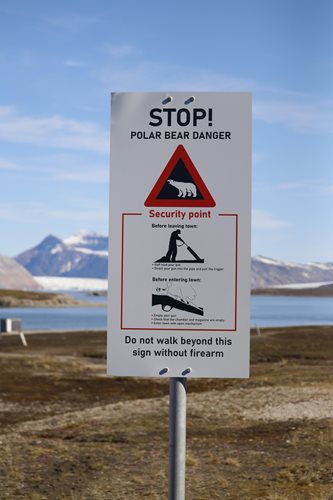
Our Norwegian minder, who carried the rifle and was in another cart pulled by eight dogs, was looking after an American couple. At first Simon drove and I was the passenger but were warned that the dogs loved to run and if the driver fell off there would be no stopping them. So off we shot at a crazy speed.
The dogs took us along gravel roads. Then when one of our dogs needed a shit, it was Simon’s duty to apply the brakes, so that the squatting animal didn’t throw the entire team into chaos. After several kilometres we stopped to offer water to the over-heating dogs, and a while further on reached a spot where a turn would be easy. As passenger, I was directed to take the leading pair of bitches around in a big sweeping circle. The attempt resulted in me being packed inside a circle of excited huskies all pushing, shoving and snapping at each other. Our minder came and rescued me, expertly guiding the dogs to make a U-turn.
Then it was my turn to drive. We set off again at terrifying speed – downhill this time – but managed the first corner without mishap. My main challenge was keeping my attention on the dogs and remembering to apply the brakes when the leading bitch needed a pee. There were so many distractions: barnacle goose goslings, snow buntings and, sitting on a nest mound beside the road, a gorgeous red-throated diver.
Most of the strikingly black-and-white male eider ducks had moved to the coast to moult when they become temporarily flightless and vulnerable, but the superbly camouflaged females had nested by the dog yard sitting on untidy piles of fluff from down plucked from their own breasts. The main predator of eider eggs is Arctic foxes who dare not approach the dogs. But glaucous gulls do take ducklings, and dogs did nothing to keep them away. Female eiders did their best to protect their youngsters from gull attack, sometimes leading a dozen fluffies into safer spots and when three or four adults could form a shield with their beaks. Several gulls circled the sitting eiders, pestering and worrying them until one newly hatched duckling was swallowed down while another gull grabbed an egg, broke into it and that also disappeared down the gull’s throat.
Nature certainly is red in tooth and claw.
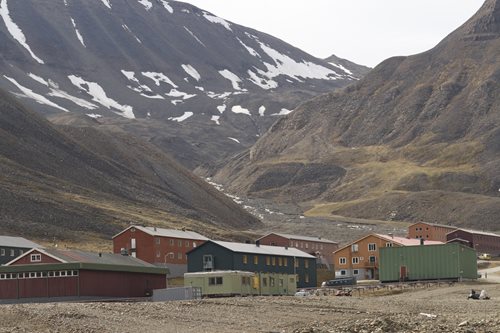 |
| Miners' huts in the Longyearbyen valley |
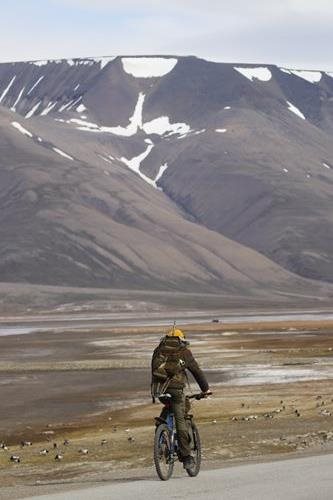 |
| Cyclist with rifle; note the barnacle geese beyond him |
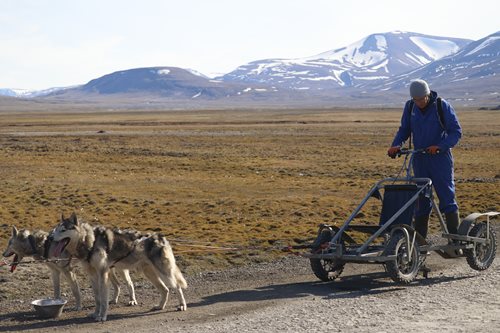 |
| Pausing for a spot of huskie hydration |
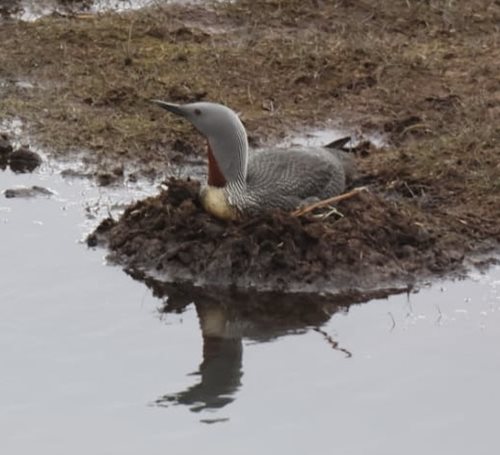 |
| Red-throated diver on its nest mound - photo by Simon Howarth |
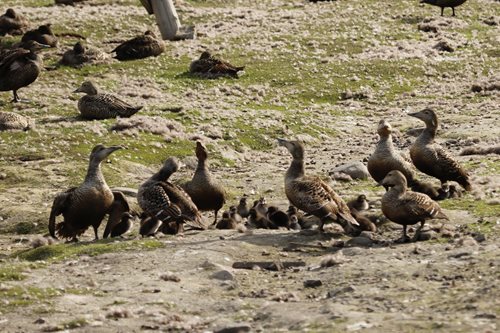 |
| Eider females trying to protect their ducklings from gull attack |
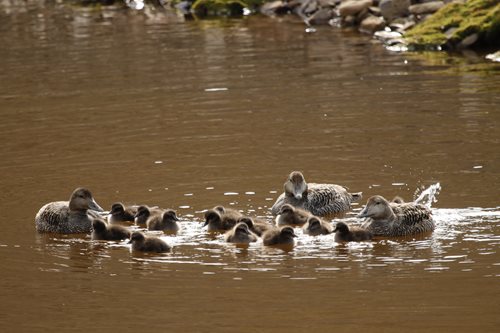 |
| Three eider females keeping ducklings safe |
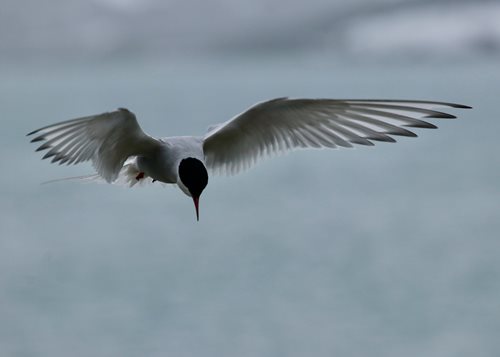 |
| Arctic tern |
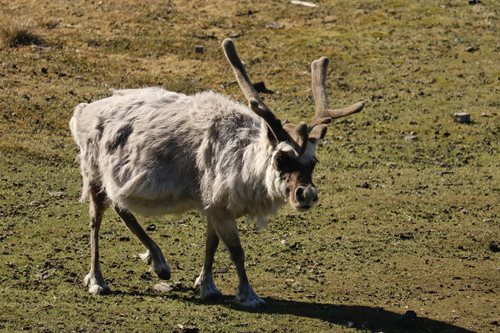 |
| A reindeer stag in velvet in June; he's moulting his winter fur |
NOTE: I've posted other relevant photos on Instagram @longdropdoc
The second part of this blog is here
Svalbard part 2